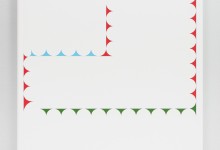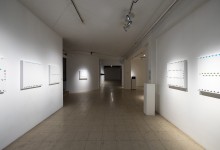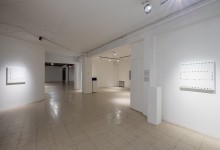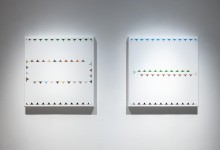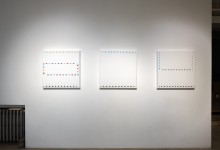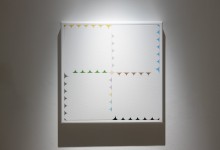Opening: Thursday, November 11, 2021 from 5:00 to 7:00 pm
Neil Harrison : Knowns
Text by Sara Nicole England
In a world saturated by images and endless content, Neil Harrison’s Knowns offers visual relief. Varying compositions of borders intersect and enclose to form structures that feel familiar. They are reminiscent of the platforms through which we deliver and receive information: newspaper layouts, social media platforms, cartoons, periodic tables, photo galleries. Where one would expect to find information within these composed structures, there is none. Instead, Harrison engages with the boundaries that hold and form knowledge by exploring their visual vocabulary.
Knowns is a reference to structures of knowing and the pursuit of knowledge, which begins by defining a boundary. By creating limits, we arrive somewhere, at something. There are few given “knowns” in Knowns. The little information that is present provides a palimpsest for multiple associations — a structure to explore meaning-making and relationships to visual boundaries. In Blue, sinking darker hues and a floating line of sky blue might yield a landscape. Weather phenomena and subterranean architecture emerge in other works, such as Red, Green and Blue. While some artists seek control over interpretation, Harrison invites endless interpretation by reducing the visual field (and the works’ titles) to essential components. Each work is an unsolvable puzzle to work through, and the longer we look, we arrive at more conclusions.
A frame is another type of boundary. The frames used in this series appear active as though they alone determine the composition of the works. Boundaries meander and ricochet off the ultimate borders of the works’ frames until the internal structure of the painting is complete. This sense of movement was not unfelt by Harrison, who describes the process of creating Knowns as “taking the boundary for a walk,” like a musician would take a bass for a walk or perform a walking bass line.
The longer we look, we arrive at more associations. The rolling repetition of the scalloped borders delivers a rhythmic and moving pulse. If the paintings became audible, how would they sound? I think about Anne Carson’s poignant use of brackets and negative space to denote gaps in the translation of Sappho. In the pages of Carson’s translation, the absence of knowns is as visually prioritized as what is known. Carson warmly describes these as blank spaces for “imaginal adventure.” The minimalism of Harrison’s work shares this capacity for imagination. Knowns explores the visual vocabulary of the boundary, but that is only the starting point. Each work speaks to the links between form, matter and meaning making. The more we look, the boundaries begin to dance, to sing, and to hold silences on the canvas.










